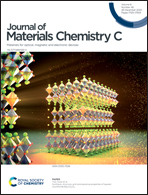Synthesis of single CsPbBr3@SiO2 core–shell particles via surface activation†
Abstract
Encapsulating cesium lead halide (CsPbX3, X = Cl, Br, and I) perovskite quantum dots (PQDs) into stable shells has been proved to be an effective strategy for improving their stability, which however usually forms agglomerated particles or alters PQDs’ original morphology and optical properties. Herein, we propose a surface activation strategy to prepare single CsPbBr3@SiO2 core–shell particles. (3-Aminopropyl)triethoxysilane (APTES) is used as a bifunctional surface ligand, which not only effectively passivates the surface defects of PQDs, but also provides –SiOCH3 and –SiOH groups for the formation of Si–O–Si covalent bonds with the subsequently introduced silanes. Furthermore, by controlling the hydrolysis rate of silanes, we realized the preparation of single CsPbBr3@SiO2 core–shell particles with an average shell thickness from 1 to 2.7 nm, and the PQDs maintained their initial cubic morphology and optical properties after coating. The stability of CsPbBr3@SiO2 in harsh environments has been effectively improved owing to the complete encapsulation of the SiO2 shell. As a result, the emission peak of CsPbBr3@SiO2 remains constant at 515 nm after being heated at 60 °C for 84 h, and the photoluminescence (PL) intensity still remains 90% after storage for 6 h in a high humidity environment. This work not only enhances the stability of PQDs for practical applications but also provides a reliable method to synthesize single core–shell particles, which can be instructive to other PQD systems.



 Please wait while we load your content...
Please wait while we load your content...